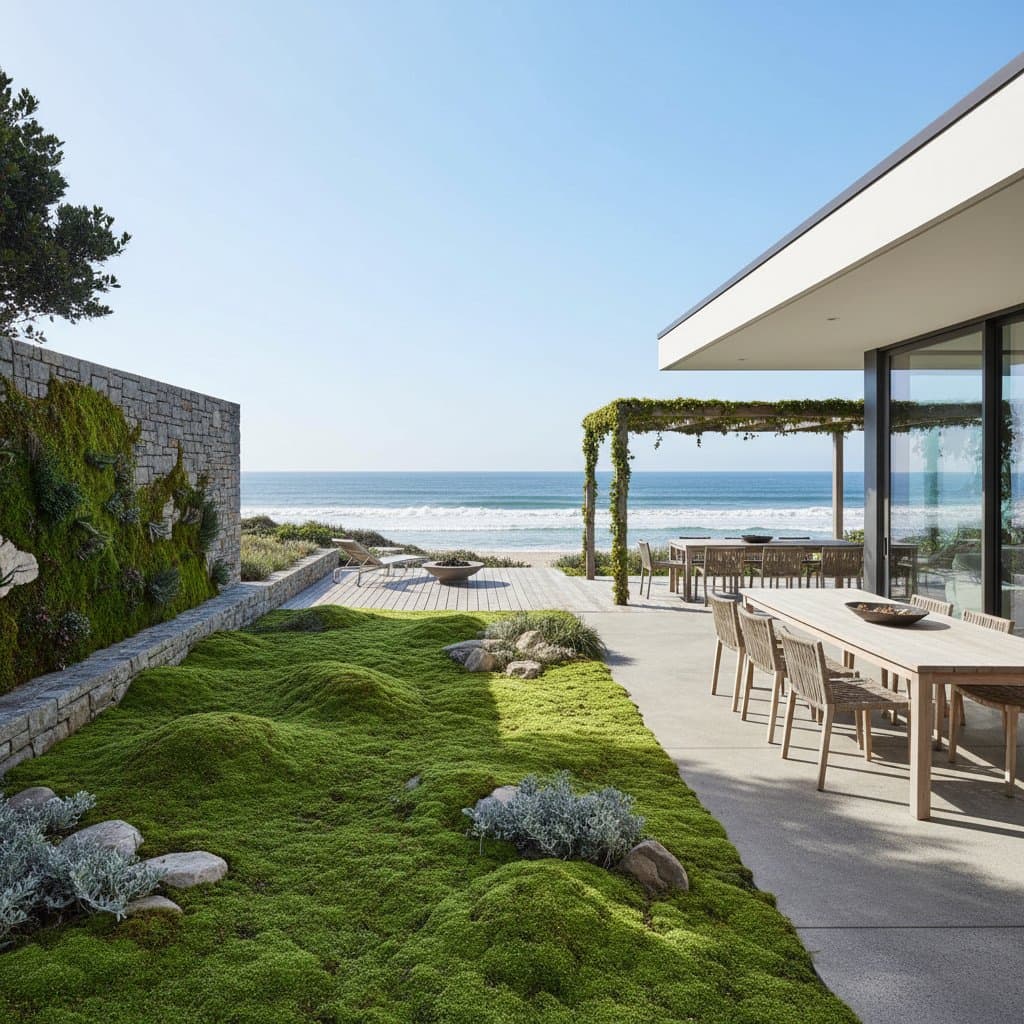9 Reasons Moss Walls Are Replacing Coastal Grass Lawns
Homeowners near the coast frequently contend with salty air, uneven turf growth, and persistent mowing demands. Traditional grass lawns, once emblematic of an ideal yard, impose substantial maintenance requirements and elevate water expenses. The coastal environment exacerbates these issues through sandy soils and salt-infused winds, rendering verdant grass challenging to sustain.
This evolution has introduced a revitalizing landscaping approach that appears organic and demands minimal effort: moss walls and moss lawns. These living elements gain popularity as turf alternatives in seaside communities. They deliver vivid foliage absent the irrigation, trimming, or complications associated with conventional lawns.
What precisely prompts moss walls to supplant grass lawns in coastal regions? The motivations extend beyond appearance. Moss combines aesthetic allure with functional advantages, aligning with contemporary coastal living. The following sections examine how this verdant, maintenance-free option can rejuvenate outdoor areas.
Sustainable Landscaping Choices
1. Effective Water Conservation
Coastal regions commonly encounter water limitations, complicating efforts to maintain green grass. Moss flourishes using ambient moisture and necessitates scant irrigation. After establishment, it draws from atmospheric humidity, rainfall, or dew to preserve its vitality.
Pro Tip: Apply a light mist of filtered water to the moss wall one or two times weekly during dry periods. This routine substitutes extensive lawn irrigation sessions.
For individuals seeking to reduce water consumption significantly, moss lawns rank among the premier sustainable selections.### 5. Diverse Color and Texture Varieties
Moss transcends a single green hue. Numerous species provide distinct shades and forms. Options range from plush emerald cushions to delicate chartreuse fronds, allowing customization to personal preferences.
Property owners often blend varieties for gentle color transitions or structured motifs. Alternatively, a consistent layer yields a sleek, understated appearance. Such adaptability positions moss as an ideal medium for inventive landscaping.
6. Harmonious Integration with Coastal Hardscapes
Moss complements prevalent natural elements in seaside architecture. It enhances appeal when positioned amid stepping stones, along retaining walls, or encircling aquatic installations. It effectively occupies gaps between pavers, where grass typically falters.
Consider pairing moss with these materials:
- Weathered teak
- Limestone or sandstone
- Pebble pathways
- Ceramic planters
This interplay of supple foliage and robust textures yields an enduring, ocean-themed visual harmony.
Practical Maintenance and Long-Term Benefits
7. Complete Absence of Mowing
A primary benefit of moss lawns lies in the eradication of mowing entirely. Moss remains dense, avoids excessive height, and sustains uniform aesthetics throughout the year. Consequently, it eliminates mower noise, fuel emissions, and routine labor.
Pro Tip: Gently remove accumulated leaves or debris every few weeks to preserve moss vitality and exposure.
This ease explains moss's status as the quintessential low-effort landscaping solution.
8. Adaptation to Challenging Coastal Conditions
Grass encounters difficulties in seaside settings due to saline atmospheres, sandy substrates, and variable hydration. Moss excels precisely in these scenarios. It favors partial shade, humidity, and permeable bases, suiting yards that confound standard horticultural practices.
Should a lawn exhibit recurring bald areas or discoloration, substituting with moss resolves prolonged aggravations. It adjusts readily, forming a plush green expanse even within demanding local climates.
9. Durability and Simple Revival
Established moss endures for decades under basic care. Damaged or desiccated portions recover swiftly. A misting, surface cleansing, and insertion of new moss pieces suffice; regrowth occurs naturally within weeks.
This self-renewing attribute renders moss lawns aesthetically pleasing and robust, providing lasting verdure free from the repetitive planting cycles of grass.
[Image: Coastal yard featuring a moss groundcover replacing traditional grass]
Guidance for Establishing a Moss Lawn or Wall
- Evaluate the surface: Moss adheres best to porous substances such as stone, concrete, or firm soil. Steer clear of artificial turf foundations.
- Select appropriate species: Opt for sheet moss or fern moss in shaded locations. For brighter exposures, choose rock cap moss.
- Prepare the foundation: Remove debris and administer a preliminary mist to facilitate moss attachment.
- Sustain moisture levels: Periodic misting upholds lushness, particularly against arid sea gusts.
- Incorporate innovatively: Employ moss to highlight planters, fountains, or sculptural pieces for an organic enhancement.
Frequently Asked Questions
How much does a moss wall or lawn cost?
Costs fluctuate by dimensions and variety, typically ranging from $10 to $30 per square foot for expert installation. Self-directed projects prove more economical with locally sourced moss.
Can moss grow in full sun?
Certain types endure sunlight, though most thrive in partial shade with steady moisture. In exposed coastal gardens, target shaded zones or employ trellises for filtered light.
Does moss attract insects or pests?
Moss lacks nectar or seeds, drawing minimal pests. It resists most insects and wildlife inherently.
Can I install a moss wall indoors?
Preserved moss walls serve as superb interior features. They demand no hydration and retain coloration for years with basic care.
How long does moss take to establish?
With adequate moisture and preparation, moss secures within weeks and achieves full coverage over several months.
Advancing Coastal Landscapes with Moss
Transitioning from grass to moss transcends mere aesthetics; it elevates daily living. This choice yields a tranquil, ecological setting attuned to seaside rhythms, while curtailing water use and labor.
Initiate with a modest moss wall or shaded area, permitting natural progression. Soon, the understated elegance of moss cultivates a serene, enduring haven befitting ocean proximity.

